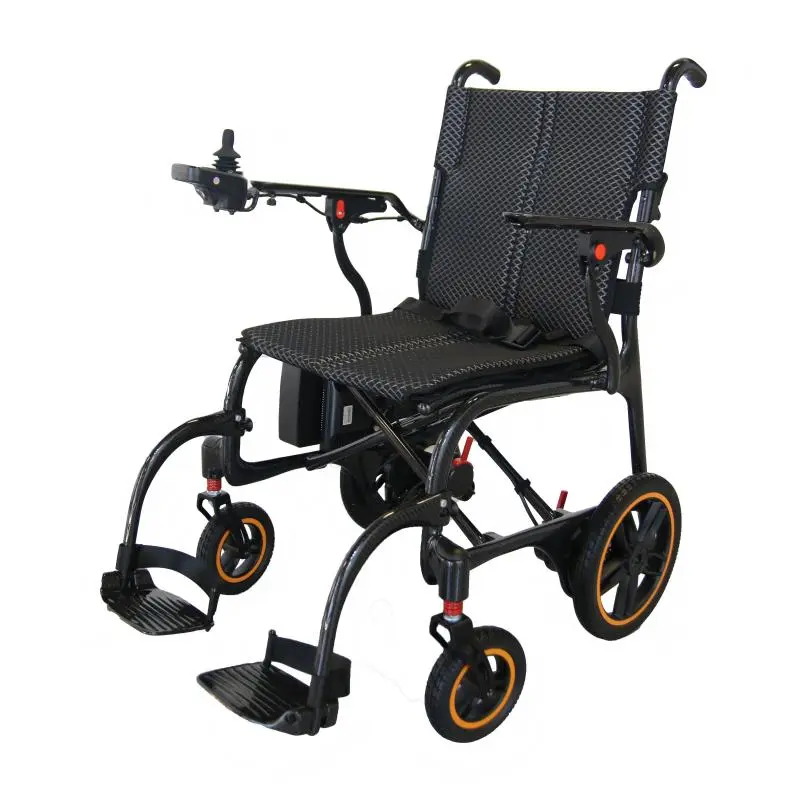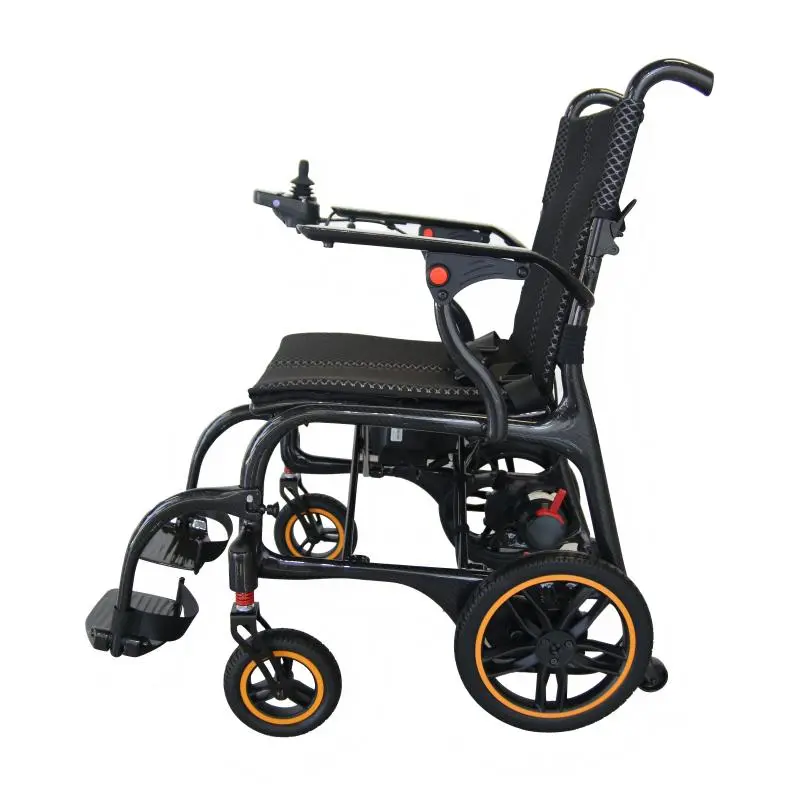Amid the trend toward lightweight, portable, and high-performance wheelchairs, carbon fiber electric wheelchairs have become a focus of attention for both the industry and users. Their unique combination of "light, strong, and resonant" material properties revolutionizes traditional wheelchair design: they reduce the burden of transfers and travel while also improving maneuverability and comfort in specific scenarios.
So, what exactly is a carbon fiber electric wheelchair? What are its advantages and limitations? Who is it suitable for? What precautions should be taken regarding purchasing, maintenance, and safety? This article will provide professional, systematic, and actionable answers to these questions, along with practical advice for hospitals, rehabilitation centers, and families.
What is a "carbon fiber electric wheelchair"?
A carbon fiber electric wheelchair is a powered wheelchair that uses carbon fiber or carbon fiber composite materials as its primary structural or key load-bearing components and is equipped with an electric drive system (motor, controller, and battery). Unlike traditional electric wheelchairs with steel or aluminum alloy frames, carbon fiber electric wheelchairs combine lightweight construction with electric drive, resulting in a product that reduces overall weight while maintaining high load-bearing capacity and rigidity.

Why is carbon fiber used in wheelchairs?
Carbon fiber offers an exceptional strength-to-weight ratio, high stiffness (high modulus), excellent fatigue resistance, and the ability to create complex free-form structures through layup and molding processes. These properties make carbon fiber the material of choice for applications requiring lightweight yet high strength, such as aviation, racing, cycling, and competitive wheelchairs. Compared to aluminum alloys, carbon fiber is generally lighter and stiffer for the same volume or component geometry, and exhibits superior fatigue and corrosion resistance. However, the material cost and molding complexity are significantly higher than those of traditional metals.
Advantages: What real difference can a carbon fiber electric wheelchair bring?
Advantages of a carbon fiber electric wheelchair:
1. Significantly lighter and more portable
2. Higher stiffness and control precision
3. Improved vibration damping and ride comfort
4. Design freedom and aesthetic advantages
1. Significantly lighter and more portable
Carbon fiber components can significantly reduce the overall weight of a wheelchair. Industry and manufacturer data often indicate that, for equivalent geometric dimensions, carbon fiber structures can achieve a weight reduction of approximately 20%–35% compared to aluminum alloys (depending on the design and layup). This is of significant benefit to users who need to remove their wheelchairs from vehicles, travel frequently, or transfer them: it reduces the difficulty of manual handling, reduces the burden of carrying, and enhances mobility. Many manufacturers, such as Dayang Medical, claim a wheelchair weight of less than 30 pounds (approximately 13.5 kg), enabling a "portable electric" lifestyle.
2. Higher Rigidity and Control Precision
The high modulus of carbon fiber means less deformation when subjected to force, resulting in lower energy loss during steering and propulsion, allowing users to experience more direct and precise control. This is particularly important in applications requiring delicate maneuvers (such as turning in confined spaces at home or at store entrances) or high-performance use (such as off-road wheelchairs and long-distance outdoor travel).
3. Improved Vibration Damping and Ride Comfort
Academic research has shown that the frame material and geometry of a wheelchair have a measurable impact on vibration transmission and energy dissipation. The use of carbon fiber composite materials, combined with appropriate structural design, can improve vibration attenuation (absorbing impact energy in a short period of time), thereby reducing the cumulative damage caused by microvibrations during prolonged riding. This improvement has potential clinical value for users with spinal conditions or those who require prolonged sitting.
4. Design Freedom and Aesthetic Advantages
Carbon fiber can be molded into integrated or streamlined shells, offering enhanced visual and ergonomic design possibilities. Modern consumer products prioritize "product affinity" and a "technological feel." Carbon fiber wheelchairs are more easily tailored to individual needs in terms of appearance and customizable color.

What are the disadvantages of carbon fiber electric wheelchairs?
Disadvantages of carbon fiber electric wheelchairs:
1. High cost
2. Complex repair and damage assessment
3. Recyclability and environmental considerations
1. High cost
The molding process for carbon fiber and its composites is more expensive than aluminum alloys and steel: the raw materials, molds, lamination, and curing (autoclave or automated layup) require high-investment production lines and long lead times. Therefore, the retail price of carbon fiber electric wheelchairs is typically significantly higher than comparable aluminum alloy products, becoming a major obstacle to widespread adoption.
2. Complex repair and damage assessment
Carbon fiber fractures differently from metals: damage can be hidden through interlaminar debonding or microcracks (matrix cracking, delamination), making it difficult to detect visually. Structural integrity after impact or a drop requires specialized testing (such as ultrasound or X-ray inspection). For routine repair shops, the cost and technical barriers to repairing carbon fiber structures are higher.
3. Recyclability and Environmental Considerations
Compared to metal materials, the recycling and reuse technology for carbon fiber composites is still developing. The cost of recycling waste carbon fiber is high, and careful assessment of the environmental impact of the entire life cycle is necessary. Some studies and industry commentary point out that while carbon fiber products are lightweight, their manufacturing carbon footprint and recycling challenges need to be addressed during industrialization.
Carbon Fiber Electric Wheelchairs: Which Companies and Models Are Producing Them?
Many manufacturers have launched carbon fiber electric wheelchairs or lightweight electric seats that use carbon fiber as a selling point. For example:
One manufacturer claims that its carbon fiber electric wheelchair weighs as little as approximately 28–30 lb (12.7–13.5 kg) and can carry 250–330 lb (113–150 kg), emphasizing portability and travel suitability. These lightweight products are often marketed as "travel electric wheelchairs" or "portable power chairs." For example, the innovative new model DY01126 from Dayang Medical, a high-end wheelchair manufacturer in China, is a portable carbon fiber electric wheelchair designed specifically for aircraft. It boasts an ultra-light weight of 13.5 kg and a high payload capacity of 136 kg.
Many wheelchair dealers market their carbon fiber series as a high-end/portable product line, focusing on its "lightweight, easy vehicle loading, long battery life (with batteries)," and "high-strength construction." The retail and rental markets demonstrate continued demand for lightweight electric wheelchairs, particularly among travelers and businesspeople.
(Note: Load capacity, battery life, folding methods, and detachability vary significantly between products. Users should consult the specific model's testing and certification data before purchasing.)

Who is a carbon fiber electric wheelchair best suited for?
1. Suitable Customers:
• Electric wheelchair users who frequently transfer, travel, and drive; the portability of carbon fiber electric wheelchairs facilitates vehicle access and intercity mobility.
• Users with high demands for precise control (such as those who engage in frequent indoor activities and are sensitive to steering response); a high-stiffness frame provides more direct control feedback.
• Chronic patients who are concerned about long-term ride comfort and vibration load may benefit from improved vibration attenuation with appropriate shock absorbers/seat cushions.
2. Those less suited or cautious:
• Budget-constrained users: The high cost of a carbon fiber electric wheelchair may be a financial burden. For basic transportation, short-distance indoor use, and easy transport, aluminum alloy or mid-range electric wheelchairs may be more cost-effective.
• Users in high-risk impact scenarios or requiring frequent on-site repairs: If the environment is prone to heavy impact or mechanical damage, the inspection and repair requirements of the carbon fiber structure may increase long-term maintenance costs.
Buying Guide: How should hospitals, rehabilitation centers, and families evaluate?
Make decisions at the intersection of the three dimensions of "technical, clinical, and economic." The following is a practical checklist:
• Confirm functional requirements: Clarify whether the primary focus is portability or performance/durability. If the vehicle is primarily for transportation, pay attention to the vehicle's net weight, folding/disassembly ease, and vehicle mounting method. If the vehicle is primarily for long-term wear, focus on load capacity, seat compatibility, and maintenance access.
• Require inspection certificates and test reports: structural strength, load limit, fatigue test, vibration test report, vehicle electrical safety, and EMC (electromagnetic compatibility) certificates, etc.
• Battery/range and aviation compatibility: Determine the battery type, Wh value, and whether the battery is removable. Inquire whether the manufacturer provides an operating manual for aviation travel.
• After-sales and repair network: Inspection and repair services for damaged carbon fiber structures are key. Prioritize brands that offer local repair services or reliable shipping channels.
• Test drives and ergonomic testing: Test handling and comfort in a multi-person test drive on various terrains (indoors, on thresholds, and on slopes). Evaluate shock absorption, seat adjustment, and ease of transfer.
Is a carbon fiber electric wheelchair worth buying?
There's no one-size-fits-all answer to this question: If you need to travel frequently, have a strong need for portability and maneuverability, and your budget allows, a carbon fiber electric wheelchair can significantly improve your quality of life. However, if you primarily use it for short distances indoors, have a limited budget, or are using it in an environment prone to impact damage, a traditional aluminum alloy or hybrid electric wheelchair may be more cost-effective. In any case, be sure to verify the structural and electrical test reports, confirm after-sales service capabilities, and test drive the wheelchair yourself before purchasing.
What about manual and sports wheelchairs?
In addition to electric wheelchairs, Dayang Medical manufactures manual and sports wheelchairs for different mobility needs. Buyers can purchase standard models at low prices or request customized options for wholesale supply. Our factory in China guarantees high-quality products certified by international standards.
With stable manufacturing capacity, we can handle both small orders and large-scale purchasing. Buyers benefit from wholesale prices, sales promotions, and reliable delivery.










